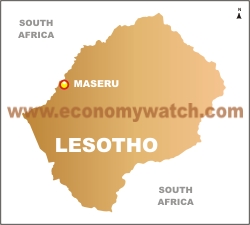Lesotho Economy, Country Of Lesotho
Please note that we are not authorised to provide any investment advice. The content on this page is for information purposes only.
Lesotho is a lower income economies coming under the Sub Saharan African region as to the classification made by the World Bank on the basis of income and region for the year 2006.
Both Agriculture and industries in the country play a significant role. As to statistics, industries sector contributes half of the total Gross State Product in the country’s economy.
Lesotho is a lower income economies coming under the Sub Saharan African region as to the classification made by the World Bank on the basis of income and region for the year 2006.
Both Agriculture and industries in the country play a significant role. As to statistics, industries sector contributes half of the total Gross State Product in the country’s economy.
Major agricultural products of the country are grains, peas, beans and wheat. Important industries are food, textile, handicrafts and tourisms. The economy also earns a major earnings from the laborers employed in South Africa.





